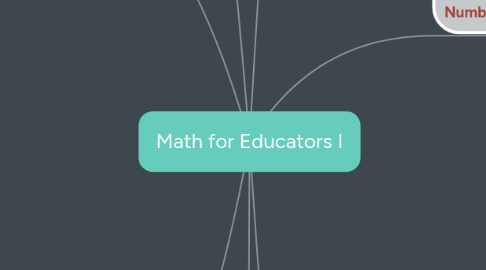
1. Projects
1.1. library exploration
1.2. Problem solving analysis
2. Sets, Numbers Operations and Properties
2.1. Contexts
2.1.1. Mathematicians' Survey
2.1.2. Who Took What?
2.1.3. To Pass or Not to Pass
2.1.4. How many Sandwiches?
2.2. Book Assignments
2.2.1. Chapter 2: Introduction
2.2.2. Section 2-1
2.2.2.1. Negation and Quantifiers
2.2.2.2. Truth tables and compound statements
2.2.2.3. Conditionals and Biconditionals
2.2.2.4. Valid Reasoning
2.2.3. Section 2-2
2.2.3.1. The Language of Sets
2.2.3.2. One-to-one correspondence
2.2.3.3. Equivalent Sets
2.2.3.4. Cardinal numbers
2.2.3.5. the empty set
2.2.3.6. more about sets
2.2.3.7. the empty set as a subset
2.2.3.8. Inequalities: an application of set concepts
2.2.3.9. Number of a subset of a finite set
2.2.4. Section 2-3
2.2.4.1. Set intersection
2.2.4.2. set union
2.2.4.3. set differences
2.2.4.4. properties of set operations
2.2.4.5. using venn diagrams as a problem solving tool
2.2.4.6. cartesian products
2.2.5. Projects
2.2.5.1. Library exploration
2.2.5.2. standards review
3. Book assignments
3.1. Strategies for Problem Solving
3.1.1. Look for a pattern
3.1.2. Examine a related problem
3.1.3. Examine a simpler case;make a table
3.1.4. Identify a subgoal
3.1.5. Make a diagram
3.1.6. Use guess and check
3.1.7. Work backward
3.1.8. Write an equation
3.2. Section 1-2 Explorations with Patterns
3.2.1. Inductive Reasoning
3.2.2. Arithmetic Sequences
3.2.3. Fibonacci Sequences
3.2.4. Other Sequences
4. Clever Counting: Combinations
4.1. contexts
4.1.1. tree diagrams
4.1.2. factorials
4.1.3. networks
4.1.4. dominoes (order)
4.2. book assignments
4.2.1. investigation 1: counting possibilities
4.2.2. investigation 2: opening locks
4.2.3. investigation 3: networks
4.2.4. investigation 4: deciding whether order is important
4.2.5. investigation 5: wrapping things
4.3. projects
4.3.1. concept map
4.3.2. assessment portfolio
5. Mathematical Processes
5.1. Contexts
5.1.1. 1. Handshake Problem
5.1.2. + or - (Gauss)
5.1.3. Finite Differences
5.1.4. Triangle Problem
5.1.5. Consecutive Addends
5.1.6. Probability (Area model/ Pascal's Triangle
6. Numeration Systems and Whole Number Operations
6.1. Contexts
6.1.1. number tools
6.1.2. base 10 number line
6.1.3. addition and multiplication tables
6.1.4. number systems chart
6.1.5. other number bases chart
6.1.6. Math to learn operation explorations
6.1.7. addition/subraction/multiplication/division
6.1.8. expressions explorations
6.2. Book Assignments
6.2.1. 3-1
6.2.1.1. Hindu arabic numeration systems
6.2.1.2. Tally numeration system
6.2.1.3. Egyptian Numeration system
6.2.1.4. Babylonian Numeration system
6.2.1.5. Mayan Numeration system
6.2.1.6. Roman numeration system
6.2.1.7. other number base systems
6.2.2. 3-2
6.2.2.1. addition of whole numbers
6.2.2.2. whole numer addition properties
6.2.2.3. mastering basic addition facts
6.2.2.4. subtraction of whole numbers
6.2.2.5. take-away model
6.2.2.6. properties of subtraction
6.2.3. 3-3
6.2.3.1. repeated-addition and numberline models
6.2.3.2. properties of whole-number multiplication
6.2.3.3. division of whole numbers
6.2.3.4. relating multiplication and division as inverse operation
6.2.3.5. division by 0 and 1
6.2.4. 3-4
6.2.4.1. addition algorithms
6.2.4.2. subtraction algorithms
6.2.4.3. equal-additions algorithm
6.2.4.4. understanding addition and subtraction in bases other than ten
6.2.4.5. mental computation and estimation for whole number addition and subtraction
6.2.4.6. mental computation: addition
6.2.4.7. mental computation: subtraction
6.2.5. 3-5
6.2.5.1. preperties of exponents
6.2.5.2. multiplication algorithms
6.2.5.3. division algorithms
6.2.5.4. division by a two digit number
6.2.5.5. multiplication and division in different bases
6.2.5.6. mental computation: multiplication
6.2.5.7. mental computation: division
6.3. Projects
6.3.1. web research
6.3.2. mathematical autobiography
6.3.3. useful number tools
6.3.4. notable number patterns
6.3.5. classroom observation
7. Integers
7.1. contexts
7.1.1. integer number line
7.1.2. chip model
7.1.3. charged field model
7.1.4. movement model
7.2. book assignments
7.2.1. 5-1
7.2.1.1. representations of integers
7.2.1.2. integer addition
7.2.1.3. absolute value
7.2.1.4. properties of integer addition
7.2.1.5. integer subtraction
7.2.1.6. defining integer subtraction
7.2.2. 5-2
7.2.2.1. patterns model for multiplication of integers
7.2.2.2. integer division
7.2.2.3. order of operations on integers
7.2.2.4. ordering integers

